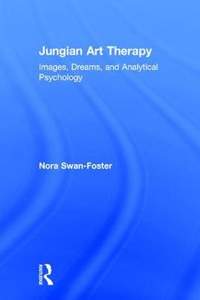
Jungian Art Therapy: Images, Dreams, and Analytical Psychology
- Author: Swan-Foster, Nora
Book
$70.75Contents
- Table of Contents
- Introduction
- My Journey into Jungian Psychology
- Why this book?
- Navigation: Two Centuries, Two Paradigms
- Circumambulating the Stages
- Gateway
- Attending
- Passage
- The Map of the Book
- Jungian Art Therapy
- Images and the Interpretation of Images
- Affect, Emotion, and Feeling
- Client/patient/analysand
- Ego
- He/She
- Masculine and Feminine Principles
- Genius Loci: Sacred Space
- Endnotes
- Section I: Gateway: Preparing to Engage
- Chapter 1: A Jungian Landscape for Theory and Practice
- Landmarks: Conscious, Unconscious, and the Symbolic
- Jung, Signs, and Symbols
- Circumambulation: An attitude for the Inner Journey
- Mandalas
- Jung's Structure of the Psyche
- The Psyche as Circle
- Consciousness
- Ego
- Persona
- Unconscious
- Shadow
- Complex
- Archetype
- Anima/Animus
- The Self: The Numinous Psyche
- Psychoid
- Psychic Energy
- Endnotes
- Chapter 2: Jungian Art Psychotherapy: Creating Bridges to the Past
- Jung's Contributions: Analytical Psychology as a Framework for Jungian Art Therapy
- Origins of Analytical Psychology
- Jung's Separation from Freud
- Jung's Creative Descent and the Liber Novus-The Red Book-1913-1930
- A Journey into Art Therapy
- Jung's Influence on Art Therapy-American and British
- American Art Therapy
- Margaret Naumburg: The Mother of Art Therapy
- Naumburg's Academic Accomplishments
- Florence Cane
- British Jungian Art Therapy and Withymead
- Champerowne's Early Days
- Endnotes
- Chapter 3: Psychic Energy: The Psyche's Life Force
- Two Kinds of Thinking and Psychic Energy
- Psychic Energy
- Tension of Opposites
- Body and the Opposites
- Movement of Psychic Energy
- Progressive and Regressive Energy
- Adaptation
- Principles of Constancy and Equivalence
- Intensity
- Jungian Art Therapy Example
- Transference/Countertransference
- Psychic Energy and Teleology
- Endnotes
- Chapter 4: Synthetic Method and Transcendent Function and Art Therapy
- Jung's Synthetic Method
- Subjective
- Objective
- Amplifications
- Art Therapy and the Synthetic Method
- Transcendent Function
- The Role of the Transcendent Function
- Constellation of the Transcendent Function
- Transcendent Function and Restoration of Persona
- Florence Cane: Transcendent Function, Opposites
- Transcendent Function, Symbols, and Art Therapy
- The Transcendent Function in Action: Jungian Art Therapy Examples
- Students
- Art and Individuation
- Jung's Two Approaches Towards Images: Creative Formulation and meaning
- Facilitating the Transcendent Function
- Endnotes
- Section II: Attending: Engaging with the unconscious
- Chapter 5: Imagination: Creating Imaginal Space
- The Imagination
- History of Imagination
- Imagination and Symbolic Thinking
- Symbolic Thinking-A Developmental Process
- Productive Imagination
- Destructive Forces and Imagination
- Clinical Example of Destructive Imagination
- Lucinda's Story: Imagination and Amor Fati
- Endnotes
- Chapter 6: Complex Theory: The Material for Transformation
- The Basic Nature of a Complex
- Image
- Autonomous
- Splitting
- The Structure of the Complex
- Cluster of Complexes
- Complexes as Expression of Energy
- Complexes, Emotions, and Images
- Tina's Story
- Complexes, Emotions, and the Body
- Carol's Story
- The Purpose of Complexes
- Progressive and Regressive Complexes
- Complexes and Multiplicity
- Complexes and Trauma
- Complexes and Transference/Countertransference
- Complexes and Art Materials
- Jungian Art Therapy Example
- Endnotes
- Chapter 7: Archetypes: Anchors of the Mythic Pattern
- Definition of Archetypes
- The Structure of Archetypes
- Jung and Archetypes
- History
- Jung's Three Developments of the Archetype
- Years 1912-1934
- Years 1935-1945
- Years 1945-1961
- The Psychological Development of the Archetype
- How Archetypes Influence Consciousness
- Rebecca's Image
- The Bipolar Archetype: Instinctual and Spiritual Poles
- Myth of Psyche: Instinctual and Spiritual
- Instinctual
- Spirit
- Claire's Story
- Self: Archetype as the Spiritual Pole
- The Relationship Between Ego, Complexes, and Archetypes
- How Do We Recognize an Archetype?
- The Archetype of Individuation
- Jungian Art Therapy: John and Emergence
- Important Summary Points About Archetypes
- Endnotes
- Section III: Passage: Engaging with Images
- Chapter 8: Dreams and Art Therapy
- The Importance of Dreams
- Freud and Dreams
- Jung's Approach to Dreams
- How to Catch a Dream
- The Structure of a Dream
- Types of Dreams
- Basic Notes on Dreams
- Dreams and Art
- Dreams Carry Energy and Emotion
- Anna's Dream: Instinctual and Spiritual
- The Story of Dawn: The Castle and The Bridge
- The Bridge Dream
- Alternative Approaches to the Bridge Dream
- Dreams of the Past
- Dreams that Sing
- Naomi and the Boy Animus
- Ellen and the Father
- Endnotes
- Chapter 9: Active Imagination and Art Therapy
- Active Imagination and the Pregnant Symbol
- Active Imagination-Experiencing the Psyche
- Jung's Red Book: The Discovery of Active Imagination
- Jung's Method of Active Imagination
- Example Dialogue with Art
- Von Franz's Method of Active Imagination
- Post-Jungian Reflections and Methods
- Active Imagination and Transitional Space
- Active Imagination and Transference/Countertransference
- Creating a Personal "Red Book" Process
- An Example of Creating a "Red Book"
- Conclusion
- Endnotes



